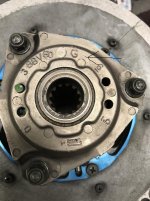Simonsweden
Member
Helix is a recut. If marked g, I believe it's a 49/41. Do a search on here for helix angles, there is a thread with the conversions.
Simonsweden
Member
Ok i saw that hauck ”G” is listed as a 49/41.
I just guess i have to test and see how it works on the snowmobile.
There are three different springs i have laying around oem green, oem white and
The green/red spring.
Thanks
I just guess i have to test and see how it works on the snowmobile.
There are three different springs i have laying around oem green, oem white and
The green/red spring.
Thanks
good thing about those is you can use regular helixs so you have a large selection of angles to choose from. You will need a strong sec spring to hang onto the belt as the roller sees no friction on helix ramp and will upshift quickly. A green dot or silver dot Yamaha spring will be needed, silver is where I ended up more times then not, however it all depends on how big of a helix youll run. Smaller angles work well because of the decrease in friction, and the smaller the angle the more pressure applied to the side of belt, allowing you to lower the tension some in spring twist=more mph.
" I’ve seen too many people increase the pre-tension on their secondary to bring up their engine rpm, myself included.
You are shooting yourself in the foot !!!!
It decreases the efficiency of transmission of power to the track while adversely affecting
the ability of the secondary to keep the shift curve flat.
Once you have your rpm where you want it, you next job is to get it to shift out the way you want.
That’s the job of the secondary.
The combination of spring and helix is what determines this.
Multi-angle is what I prefer.
The secondary spring directly equates to side-force on the belt.
The idea is that the more side-force you have on the belt, the less efficient it is because of belt drag.
Secondary pre-tension (wind) should be around 16-24 ft lbs.
What I try to do is get to the minimum side-force possible without slipping the belt in the secondary.
Too much side-force and the clutch will back-shift too fast and put you in too low of a ratio and over rev when you stab the throttle out of a corner.
Too little and it won’t back-shift fast enough and it will react sluggishly (bog)
and you’ll loose rpm climbing hills or trying to maintain high speeds.
Lastly, I’m a believer in low gearing, its less work for the clutches and engine they will run cooler.
Most sled heads don’t realize that the factory gears sleds for speeds higher that the sled will ever reach.
They never reach a true 0.75:1 over drive ratio, also the track and engine combinations the owners and after-marketers add,
won’t allow the motor to pull the tall gearing
(pulls the rpm down on a long climb or high speed). "
// Tom Hartman
CEO and Owner of Hartman Inc.
You are shooting yourself in the foot !!!!
It decreases the efficiency of transmission of power to the track while adversely affecting
the ability of the secondary to keep the shift curve flat.
Once you have your rpm where you want it, you next job is to get it to shift out the way you want.
That’s the job of the secondary.
The combination of spring and helix is what determines this.
Multi-angle is what I prefer.
The secondary spring directly equates to side-force on the belt.
The idea is that the more side-force you have on the belt, the less efficient it is because of belt drag.
Secondary pre-tension (wind) should be around 16-24 ft lbs.
What I try to do is get to the minimum side-force possible without slipping the belt in the secondary.
Too much side-force and the clutch will back-shift too fast and put you in too low of a ratio and over rev when you stab the throttle out of a corner.
Too little and it won’t back-shift fast enough and it will react sluggishly (bog)
and you’ll loose rpm climbing hills or trying to maintain high speeds.
Lastly, I’m a believer in low gearing, its less work for the clutches and engine they will run cooler.
Most sled heads don’t realize that the factory gears sleds for speeds higher that the sled will ever reach.
They never reach a true 0.75:1 over drive ratio, also the track and engine combinations the owners and after-marketers add,
won’t allow the motor to pull the tall gearing
(pulls the rpm down on a long climb or high speed). "
// Tom Hartman
CEO and Owner of Hartman Inc.



